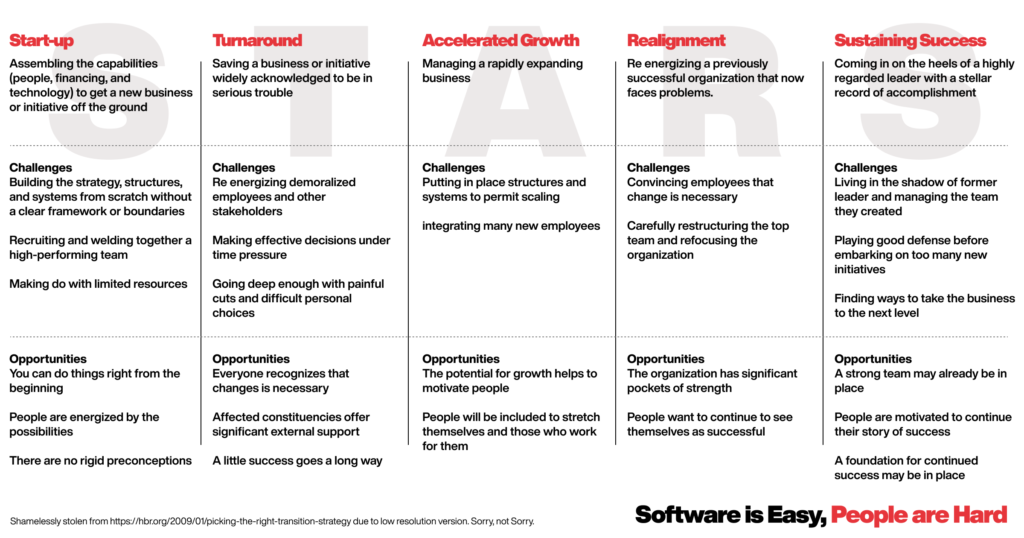The sometimes hard-to-swallow truth is that, at scale, flat organizations don’t work. As a company grows they need to be chunked into smaller, more manageable pieces. Companies split up into domains, groups, tribes, coagulations, or what is defined in the most recent blog post or book that the operations lead just read.
These “clumps of teams” primality exist because there is a maximum number of teams that can report to one person. When a company gets to the size where it needs to perform a clumpification (clumpening?) it goes through a painful process of working out which team goes in which group.
How you collect these teams together really depends, you can group them by competence, business function, or aligned business goals. However it’s never perfect, you always end up with a few misplaced teams, or worse an overflow group consisting of all the teams that didn’t fit nicely anywhere else.
Over time I saw people, and myself, struggling to define visions and missions for these team groupings, I feel like you had two options. Either try and include all of the teams into one vision and end up with something like:
Our vision is to do the things that these three teams are doing, and a bit from that team over there, and oh don’t forget the important stuff Steve is doing.
Alternatively, you end up with a clear sharp vision that doesn’t represent everything you’re doing and isolates some of the team, or individuals, in the group.
So I formed the opinion that investing energy into group visions and missions maybe wasn’t worth it, and these kinds of things would drop down in priority for me.
I was wrong!
Storytime!
The Fire and The Phoenix.
A couple of years ago I was asked to step in a support a team that was struggling.
Phil, you’re good at understanding why people are unhappy and making them happy again, these peeps are unhappy, pls fix.
When engineers say that “things are burning” and throw around the “this is fine” dog meme sometimes they’re being a little over dramatic.
However, this team was so on fire it burnt itself to the ground. Through a series of unfortunate events including miss management, lack of dealing with underperforming engineers, terrible legacy engineering decisions, and some individuals that I can only describe as “lacking the ability for normal human interaction” everything fell apart. I was not able to save this team.
Everyone quit, except for one engineer and they only agreed to stick around for a month as long as we promised to transfer him to another team.
I had one month till I had 0% of a team maintaining a critical part of the company’s infrastructure.
With a little bit of luck, we can make it through the night.
We had to clear the decks, start again and do it quickly. We decided to create two new teams to split the problem space of the team. We didn’t sugarcoat the situation, we gave one of the teams the code name “Phoenix” and the other “Fawkes”.
The latter had the unfortunate side effect of incorrectly labeling me as a Harry Potter fan, which I’m not, there just aren’t very many famous Phoenixes!
We were super lucky to hire a couple of incredible people. Before they started we briefed them on what they were walking into, made sure they were still ok with it, and we all ran at the problem head-on. With metaphorical battle axes drawn, like a small group of Hobbits, running at a massive group of angry Orcs.
Through a little aggressive stakeholder management, a good bit of exemplary cheerleading, some amazing talent (not mine), a little “Dunkirk Spirit”, and a whole bunch of luck we made it through, and within 16 months the teams were smashing the targets that the old team not been able to hit for years previously.
Double down on disaster.
We got the approval to invest in the space, create a group of teams, hire some more people and push the problem space forward.
Just as the teams were getting into their stride, excited for the new opportunities more investment would bring, a few notifications came down from above in quick succession. A process that will end up becoming very familiar to a few tech companies over the next year.
First, we were told, “The new headcount you asked for, we need to cut it a bit”. Then, “What are you able to deliver next year if we didn’t give you any additional headcount?”. Follow, finally, by “So…. we need to cut 10% of current headcount.. across the whole company, who do you pick?”
The company was an early mover in the wave of layoffs that happened in 2022.
Re, re-org and the crowd say ‘productivity bomb’
As part of the lay-offs we had a big re-org across the company, my group was moved to a new domain and I inherited a few new teams that had come to the company from an acquisition a year earlier.
As everyone processed what had happened, and we tried to work out what direction we were going to take the group in everything stopped for a good couple of months.
As we started to work out the details it became clear that the initial quickly drafted grouping of teams hadn’t quite been perfect, we had some duplication of similar efforts in teams, people not quite in the right place, and a few other challenges.
So we had to do a second re-org and this is where the wheels really started to come off.
Everything is “Fine”
We presented the new group structure to the teams, explained the KPIs that we wanted to achieve with the group, gave our reasoning, and gave them two weeks to say their goodbyes to their teammates (no one was let go this time, but we removed some teams and moved some people).
The teams got on with it, without much of a grumble. Every time I asked, everything was “fine”. Everyone liked their new teammates and the teams started to get going with their new scopes.
Everything remained “fine”.
But then I started to get an uneasy feeling, I was getting very little engagement in the group slack, this might not seem like much but the group’s emoji reaction game has previously been stellar. It was very quiet.
I failed to get volunteers for a couple of important “extracurricular” activities. Something that I’d never had an issue with before. In fact, I had a reputation for being the person whose requests for help were always so compelling no one ever felt they could say no.
Everything was “fine”, but the “fines” were beginning to sound a little like the “fines” my partner uses when everything is anything but.
Everything was not fine.
Engagement Survey
The company does an anonymous quarterly engagement survey to assess the vibe across the whole company. My group’s results were through the floor. Around 60% felt they weren’t going to be in the company in 12 months’ time, and the engagement number was 30/40% below where they had previously been.
My Group had been using “fine” to avoid talking about the issues that they were feeling. So I immediately canceled all of my meetings for the next week and committed to doing a 1-2-1 with everyone (30ish people) in my group.
Luckily at this point, I hadn’t completely destroyed all the trust of the group so most people were very willing to share their feelings with me on a 1-2-1 basis. I learned some interesting things.
The period before the second restructuring was too long, we spent too long trying to make sure we understood what was going on, so the group felt in limbo. They all had a gut feeling that something was coming and because the last change had included lay-offs they had anticipated maybe more were coming.
When we did make the change they felt it was very ‘top down’ and that they hadn’t been consulted, even though we had consulted the lead of the team all the way. I had assumed the leads were more “onboard” with what was going on and I didn’t factor in how fragile they were feeling as well.
But mostly I got the feedback that no one felt connected to a ‘common goal’. I had driven the re-org around two really simple, and what I thought clear, KPIs:
- Increase revenue from one product
- Increase daily active users for the other.
In my head, it was super clear how all the teams in the group contribute to these KPIs, and felt that these lovely lean KPIs were a great North Star for the group.
However the group didn’t know what was going on in my head, I had multiple people in the group that didn’t know me or what I stood for, and those that I had built trust with were feeling I hadn’t protected them well enough from the organizational changes.
Everyone was missing a vision and mission to get behind, something to connect I was completely wrong there not being a need for a group vision and mission.
The STARS Align
I was bumbling about trying to work out how I got it so right the first time, and so wrong the second time. Then I stumbled across Michael Watkins’s STARS framework.

STARS is an acronym for all the possible stages you might find an organization in, Start-up, Turnaround, Accelerated Growth, Realignment, or Sustaining Growth.
It outlines the main challenges in each of those phases, like all models it’s an approximation, but I found it incredibly useful.
Where I had been successful the group had been in the Turnaround phase, heading towards a catastrophic cliff. The challenges this throws up I’m good at. Cheerleading and Energizing people is something that I get a significant buzz out of and I think I’m pretty good at it.
The other thing that it required was strong tactical leadership, as we chaotically ran towards our simple goal of “not imploding” I was able to make quick, tough, tactical choices. Something that from my agency experience I’m very comfortable with.
Realignment
However, after the layoffs, my group was much more in a realignment phase, which meant strong strategic leadership was needed. I needed to convince the group that the change was needed and important.
Without a very visual fire to point at and shout “FIRE, FIRE” I tried to use two very naive and simple KPIs as a point of focus for the group, but it wasn’t enough the group in general couldn’t connect what they were doing easily to those KPIs.
I needed to create a much better connection for them.
Even if you don’t feel you need a group/domain/tribe/clump/coagulation vision and mission consider what stage in the STARS framework you’re in and how important it is to focus on giving your people something to bind them together with a common goal.



